8 useful KPI-guidelines to build up your business
12 min read
SPI Research’s Maturity Benchmark shows that you outperform everybody when your company has a high maturity level.
Time tracking
Build your perfect data foundation for spotless invoicing and deep business insights with easy time tracking.
Project management
Be a world champion project manager. Keep your projects on track - and profitable.
Resource management
Efficiently staff projects and run a predictable business with confidence.
Insights & Reporting
Get smarter - faster - to make clever decisions for long-term growth impact.
Project accounting & Invoicing
Invoice everything - fast and accurate - while staying on top of project finances.
Staff & Salary
Give accountants and HR an intelligent tool to eliminate draining administration.
Financial Systems
TimeLog offers standard integrations for all your favourite financial systems. Save time and reduce manual tasks.
Payroll Solutions
TimeLog offers standard integrations for multiple payroll solutions. Get easy salary administration and only enter payroll information once.
Add-ons
Track time automatically via Outlook, use gamification or find another add-on that can support your business.
Multiple Legal Entities
You can create synergy between your departments and across borders and offices with the Multiple Legal Entities module from TimeLog.
Business Intelligence
Utilise the insights you get from TimeLog to the fullest. Our system is ready to integrate with multiple BI solutions.
Partner Integrations
TimeLog PSA is part of a large ecosystem. Get an overview of all the partner integrations in the TimeLog family.
Economy department
Save 1-2 days a month on your invoicing process.
Project teams
From planning to execution and evaluation. Robust tools for every project manager.
Management teams
Create a performance-driven culture with solid reporting capabilities.
Large enterprises
Enhance operations and performance across entities, countries and departments.
NGOs and non-profit organisations
Simplify internal processes, spend less time on administration, and get documentation in place - at a discounted rate.
Blog
Get inspired to run an even better business with articles, guides and analyses.
Guides, podcasts and webinars
Get access to templates, guides and webinars that help and inspire you.
Help Center
Looking for help material and user guides to the TimeLog system? Look no further. Find all the help you need now.
Get a single source of truth
Discover how companies maintain a single source of truth across borders, departments, and currencies.
Get integrated
Discover the advantages customers gain from utilising our integrations and API.
Reporting in real-time
Explore how others leverage reporting to optimise their processes and make informed decisions.
Get started with resource planning
Discover how other companies thoroughly grasp their resources and enhance their ability to predict future trends.
Improved project financials
This is how the efficient financial toolbox from TimeLog helps project managers and CFOs improve their project financials.
Faster invoicing
Discover how other companies have slashed the time spent on invoicing by 75% - and uncover how you can achieve the same efficiency.
The Story of TimeLog
Get insights on TimeLog and how we can help you grow and evolve your business.
Employees
See who shows up every day to deliver the best PSA solution.
Career
What's life like at TimeLog? Are we hiring? Get the answer here.
Partner
Create even more value for your customers, as well as ours, as a TimeLog Partner.
Premium Service
Online Help Center, tailored onboarding and support from Day 1.
Corporate Social Responsibility
We work to ensure a positive impact on planet, people and businesses.
Security and GDPR
Learn more about how we work to keep your data safe and provide maximum security.
6 min read
SPI Research’s Maturity Benchmark shows that you outperform everybody when your company has a high maturity level. See what maturity is and how you figure out your company's maturity.
![[Explainer] What does it mean to be a mature company?](https://timelog.com/hubfs/what-is-maturity-explainer.webp)
Here are 3 quick key figures from SPI Benchmark to trigger your interest:
These are just three of the most eye-catching differences between companies on levels 1 and 2 on SPI Research’s maturity scale.
The scale goes all the way up to level 5.
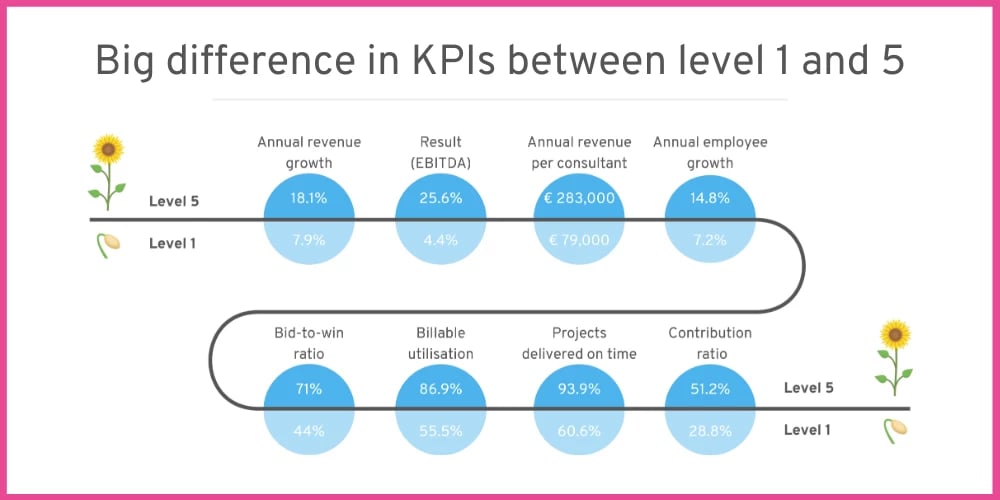
This is included in SPI Research’s benchmark for the consultancy industry.
In the benchmark, more than 500 companies are measured against more than 100 key figures.
SPI Research is a global organisation that does research and education for Professional Services organisations (consultancies). They at the same time offer consultancy for companies seeking a maturity transformation.
They have developed the PS Maturity Model™, which since 2007 has been used by 20,000 project-oriented consultancies as a development tool towards higher maturity.
You can read more about SPI Research on their website.
The conclusion is that your KPIs look better when the maturity level of your company is higher.
56% of all companies are still at level 1 or 2, and the likelihood that your company is at the same level is high.
Naturally, we need to get you up to level 5, and the article here offers inspiration and help.
But first: What makes up a mature company?
Maturity doesn’t sound sexy.
It sounds like a bowl of ageing companies with a dust of dried-up innovation ability.
But the association is deceiving.
In reality, maturity should take your thoughts to words like professionalism, excellence and competitiveness.
Maturity is the ability to:
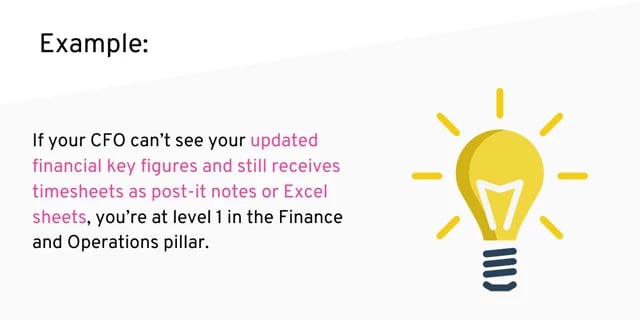
The SPI benchmark shows that maturity has nothing to do with age. You can run an infant company that is relatively mature at the same time.
It all comes down to your organisational professionalism.
To grow your maturity, you need to do it on an operational level. You need to be able to see when you are mature and when you’re not if you need to develop your company.
And this is where SPI Research’s maturity model can help you.
The model splits up maturity into 5 performance pillars. And you can be more or less mature in the different pillars. The pillars are:
Each pillar has its characteristics that reveal the different maturity levels.
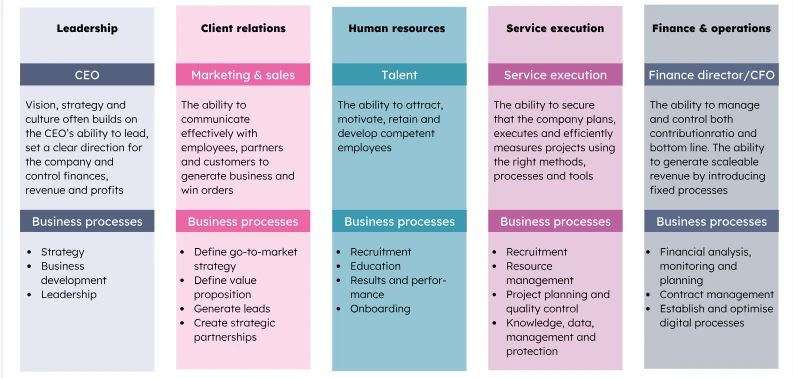
You can use the maturity model to test how mature/professional your company is within the five pillars.
If you would like to see what characterises the 5 levels, keep reading as we examine each one in more detail.
In this section, you can see the average KPIs and typical characteristics for each maturity level.
56% of all companies are still at level 1 or 2. There is a high likelihood that your company is also at the same level.
In the graphics, you can check off which descriptions match your company.
This gives you a sense of your maturity level and shows you which areas you can improve.
We'll start with level 1 since we find most companies at this level.
If your company is at level 1 on SPI Research’s maturity scale, it is characterised by ad hoc workflows.
SPI Research calls this level the heroic level because success is often driven by a few individuals delivering extraordinary performances—not a well-oiled organisation.
The work environment is chaotic and opportunistic. It requires employees to take on numerous roles, and specialists have difficulty exploiting their core competencies.
You have different perceptions of best practices and quality across the company, which makes it challenging to provide a quote and deliver quality on time.
The IT landscape is fundamental, based on Excel sheets, and your systems are not integrated at this level. Leaders, project managers, and financial controllers do not have insights into the company's key figures, and they regularly make decisions based on old data or gut feelings.
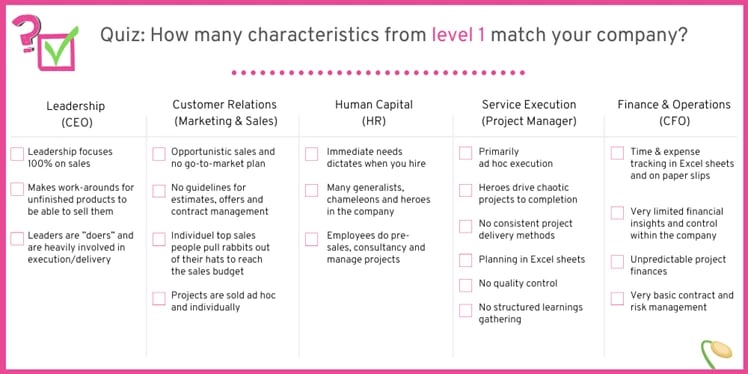
At level 2, you start to incorporate work procedures for different functions across the company. In single areas, you have established best practice standards.
However, neither processes nor best practices are documented and made available to the rest of the organisation.
Operational excellence can exist within single departments or specialist teams, but not across functions or the organisation.
More functions are digitalised but not integrated, making it difficult to get an overview of key figures.
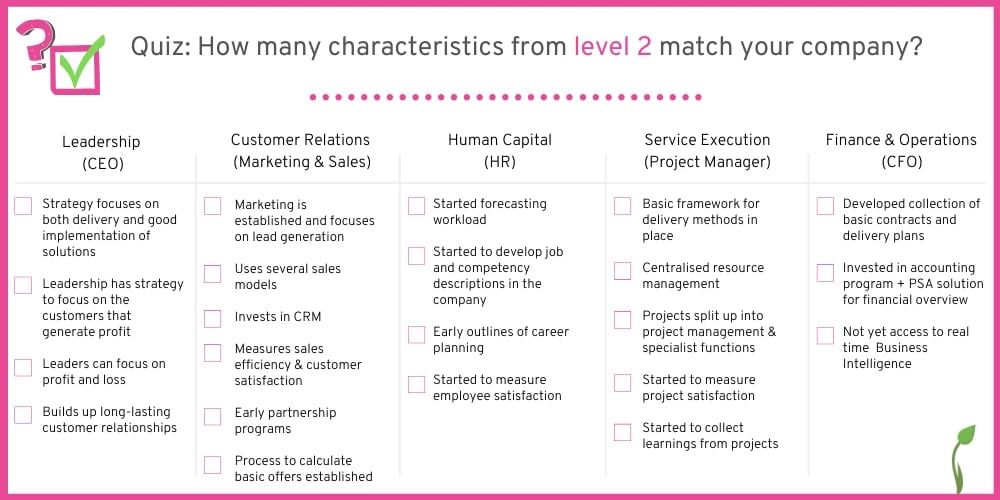
This is the level most companies should strive for.
At level 3, standard processes and management principles are broadly anchored across your organisation.
At the leadership level, you have established targets and management mechanisms for finance and project delivery. You deliver projects efficiently and focus on aligning processes within and across organisational functions.
You now use standard methods and quality measurements in project execution, which opens the options for creativity and overperformance. In the fight for the best employees, you become attractive to ambitious talents.
Digitalisation and automation of project and resource management through a PSA system is in place, and you have deep insights into project execution and finances.
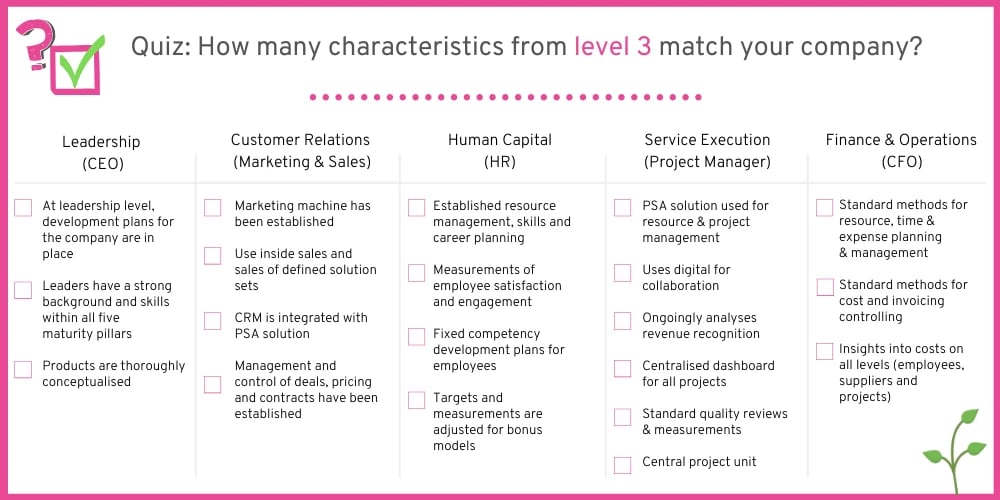
At level 4, your company is an acute management, measurement and execution machine.
You have a Business Intelligence setup that allows you to measure critical vital figures, and Sales has a good CRM tool to forecast the future.
Within each performance pillar, you have worked out detailed operational principles for execution, tools and measurements. These principles let you manage finances and quality stringently and with excellent transparency.
As an organisation, you have established quantitative and qualitative measurements for sales, customer retention and market penetration.
At level 4, you start to select your customers and projects because you do not waste time on unprofitable businesses.
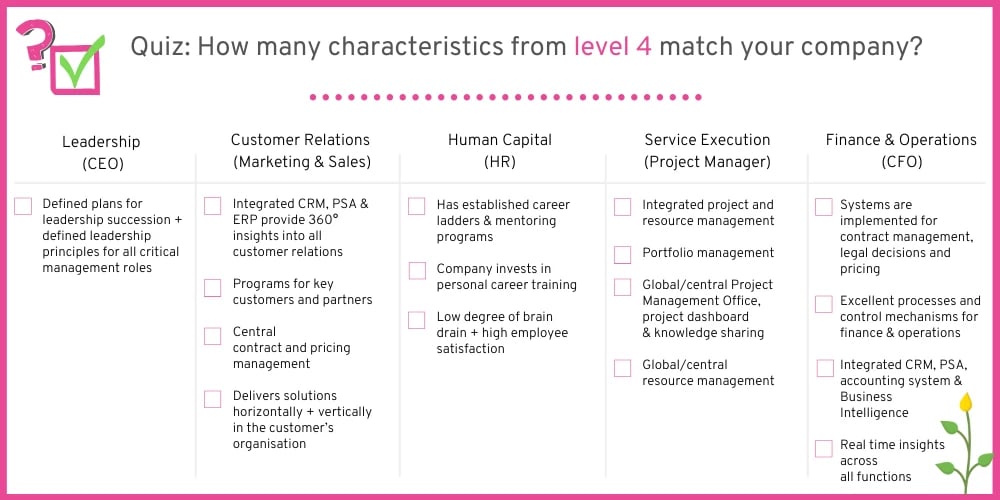
If your company has reached level 5, you have fought for it.
I want to congratulate you. The path to level 5 is hard, but the reward is matched, and in most metrics, there are higher profits when you go from level 4 to 5 than when you go from level 3 to 4.
This means that you have basic frameworks in place for management, measurement, and execution. Now, you have established targets for data collection and learning from everything you do. Based on your data, you require constant revision, optimization, and innovation of your processes, which makes you highly competitive.
At level 5, firefighting is history because your organisation has become highly sensitive across teams to the need to put out potential fires before they start.
Finally, your digital landscape is fully integrated and standalone systems do not exist. Your PSA solution is completely integrated with your CRM and BI tools, and you have practically eliminated data gaps in your reporting.
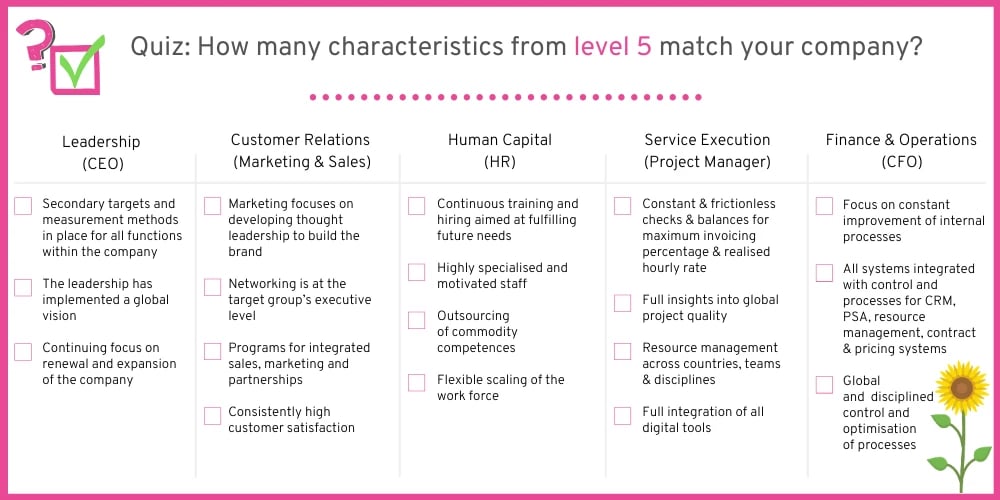
If you want to develop your company’s maturity level, it can be challenging to get started.
And five tips will not get you halfway or make you succeed. But they are pulled out of our internal work in TimeLog with optimising and making our organisation more mature.
I can tell you that we are in a good process, and I hope you can find inspiration in our experiences.
You may find it weird to read this article about maturity coming from a software company.
And maybe it is.
However, through implementing TimeLog for our customers, we have repeatedly seen how our customers move up on the maturity scale.
No IT system can improve an organisation’s work procedures alone. That is also true for TimeLog. However, our PSA solution encourages a more well-considered approach to work processes supported by the system.
At the same time, the PSA solution provides your company with an architecture to link the work processes and enables you to optimise the entire organisation.
Especially if you run a consultancy business.
If you would like to know more, you are welcome to book a free 20-minute investigative conversation with one of our skilled consultants. We might be able to help you raise your company's maturity level.
Since 2017, TimeLog has cooperated with SPI Research to publish the early Professional Services Maturity Benchmark for the consultancy industry.
To our customers, TimeLog is often instrumental in a transformation towards higher maturity, and we, again and again, see how our customers develop – not only in size and revenue – but also in professionalism and maturity.
TimeLog releases the SPI benchmark and an Executive Summary with the benchmark's most important key figures and takeaways.

12 min read
SPI Research’s Maturity Benchmark shows that you outperform everybody when your company has a high maturity level.
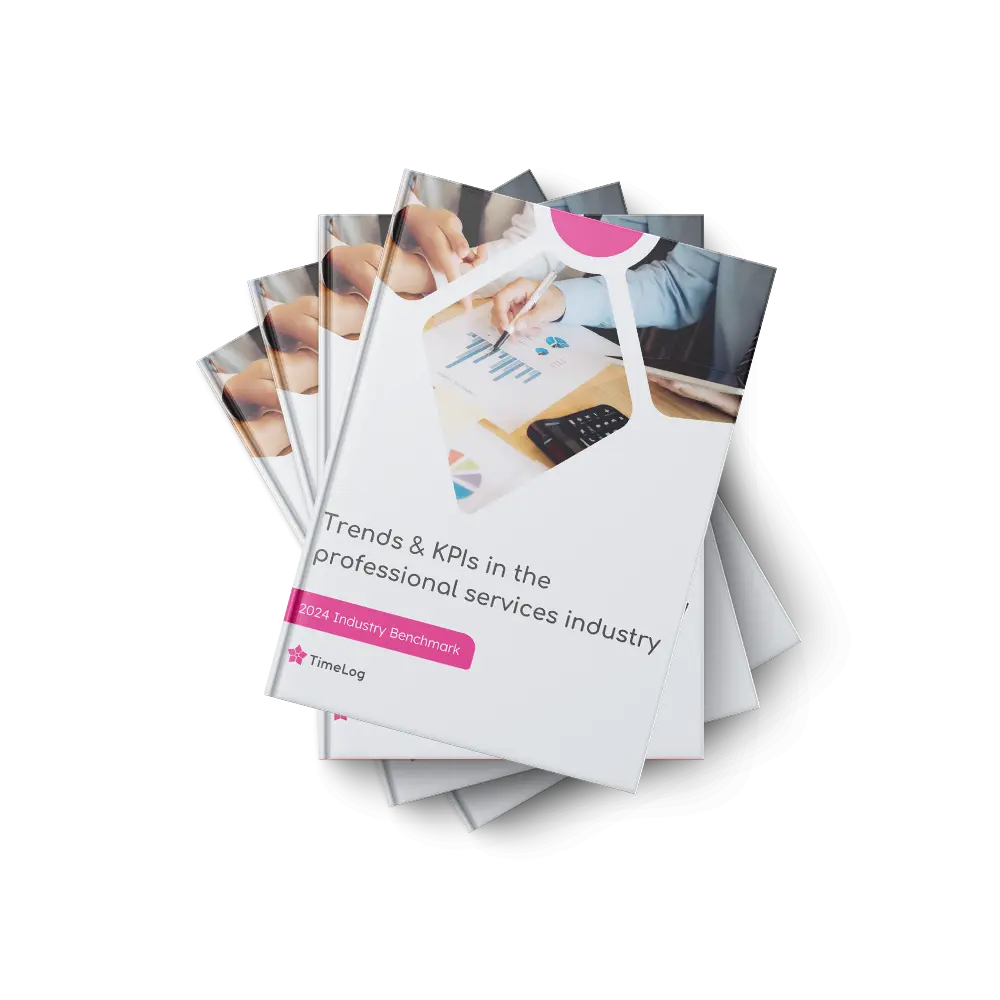
8 min read
SPI Research’s Maturity Benchmark shows that you outperform everybody when your company has a high maturity level.

12 min read
SPI Research’s Maturity Benchmark shows that you outperform everybody when your company has a high maturity level.

2 min read
SPI Research’s Maturity Benchmark shows that you outperform everybody when your company has a high maturity level.

3 min read
SPI Research’s Maturity Benchmark shows that you outperform everybody when your company has a high maturity level.

6 min read
SPI Research’s Maturity Benchmark shows that you outperform everybody when your company has a high maturity level.

4 min read
SPI Research’s Maturity Benchmark shows that you outperform everybody when your company has a high maturity level.

7 min read
SPI Research’s Maturity Benchmark shows that you outperform everybody when your company has a high maturity level.

5 min read
SPI Research’s Maturity Benchmark shows that you outperform everybody when your company has a high maturity level.